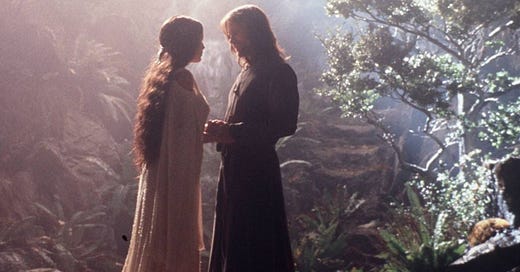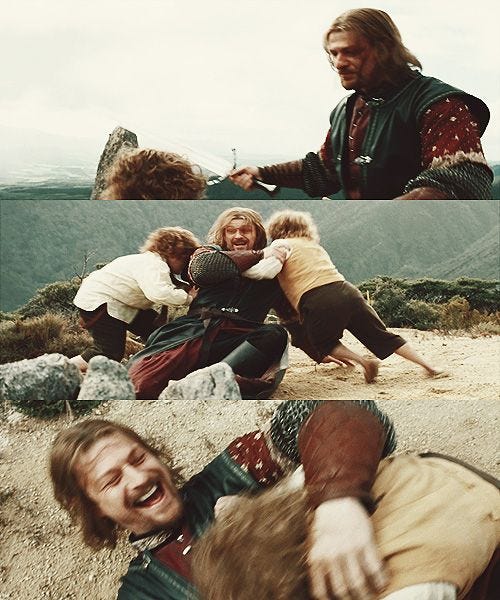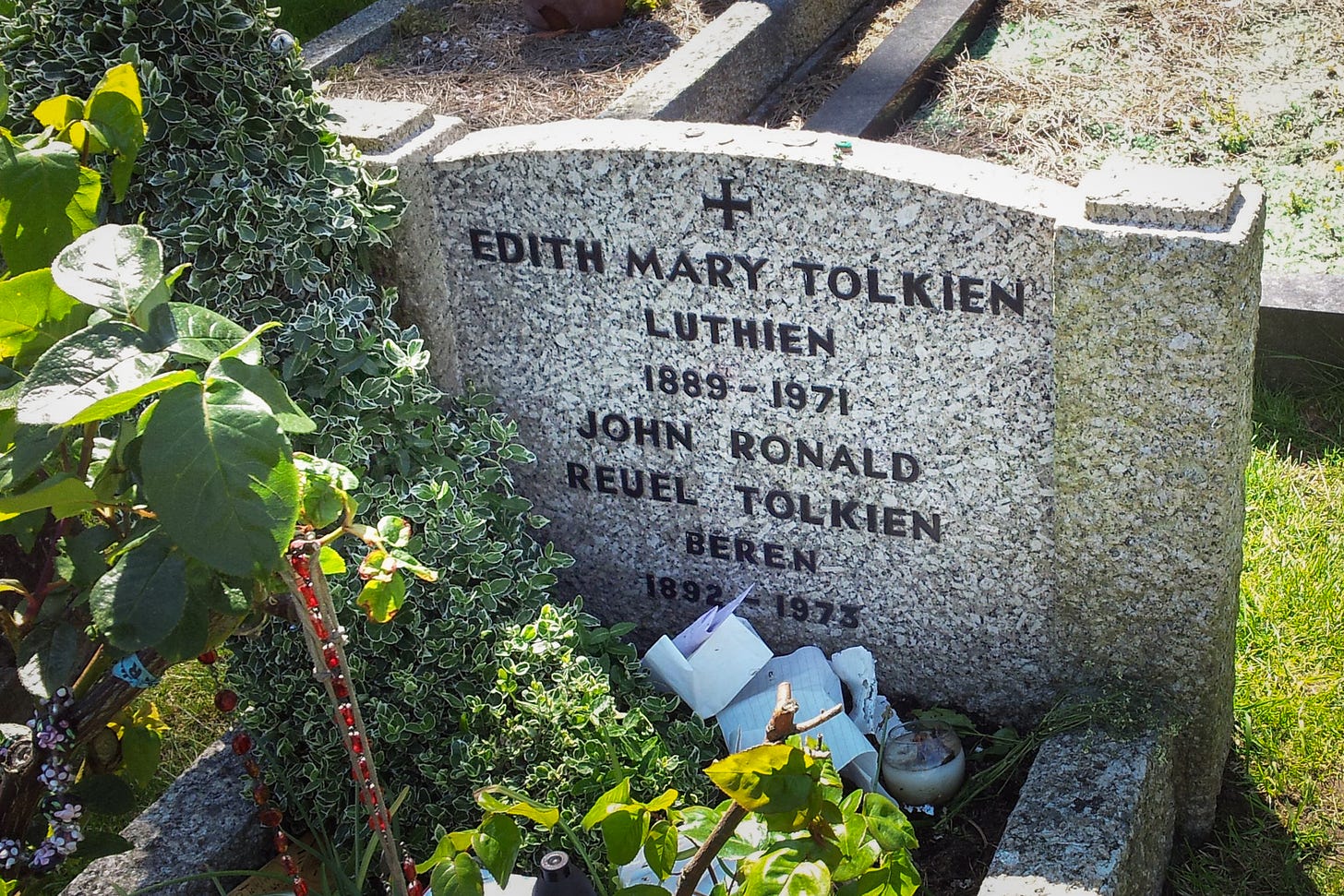💗 Lewis' Four Loves in Tolkien's Lord of the Rings
Examples of Affection, Friendship, Passion, and Charity in Middle-earth
It’s been a “Live, Love, Lord of the Rings” week here at Jokien with Tolkien. It’s the week of Valentine’s Day and the last two newsletters I’ve sent out have focused on Finding the Five Love Languages in the Lord of the Rings and Lord of the Rings Valentine’s Day Cards. As I thought about how to end the week focusing on love and Lord of the Rings, I decided that I’d take a page from fellow Inkling C.S. Lewis’ book The Four Loves and look for examples of each of them in Tolkien’s works.
So in today’s newsletter I’m going to highlight an example or two of each of the four loves — Affection, Friendship, Passion, and Charity — as depicted in Tolkien’s The Lord of the Rings.
Lewis' Four Loves in Tolkien's Lord of the Rings
Examples of Affection, Friendship, Passion, and Charity in Middle-earth
1. Storge (Affection)
C.S. Lewis begins The Four Loves1 discussing storge, which he defines as “affection” (31). “This warm comfortableness,” he continues, “this satisfaction in being together…ignores the barriers of age, sex, class, and education…even the barriers of species!” (32)
Affection is a love that grows so slowly that you often cannot rightly point to the moment it began and a love that often exists alongside the other loves, where it can “enter into the other loves and colour them all through and become the very medium in which from day to day they operate” (34). Affection is the broadest of loves, a love that can and does develop for “the people with whom you are thrown together in the family, the the college, the mess, the ship, the religious house” (37).
Storge love — affection — makes me immediately think of the broad love that the Fellowship develops for each other over the course of their journey. While certain members are closer to each other in friendship than others (more on that in a moment), all the members of the Fellowship develop a shared bond of affection for each other in The Lord of the Rings. Indeed, their group title itself — Fellowship — conveys this very type of relationship: a fellowship is a group of companions united by shared purpose or interests.
One of the best examples in the Peter Jackson films of this love is the training session that Boromir holds for Merry and Pippin during a bit of downtime on their journey. The serious endeavor devolves into a tangle of laughter and smiles as the two hobbits connive to feign an injury to take down Boromir and then also fell Aragorn when he comes over to investigate. These are men (and hobbits) who care for each other and have each other’s best interests at heart because, though they did not choose each other as companions, destiny brought them together and gave them a set of shared purposes and experiences.
While this moment is a contrivance of the filmmakers and doesn’t appear in the books, the Fellowship does not lack affection for each other in the books. Though it is more often alluded to than explicitly shown, one instance where it is clearly displayed is when the three hunters — Aragorn, Legolas, and Gimli — are reunited with their “quarry” — Merry and Pippin — in Isengard.
Greeted by the sight of Merry and Pippin smoking and at their leisure after having had a hearty meal, Gimli erupts into feigned indignancy:
You rascals, you wooly-footed and wool-pated truants! A fine hunt you have led us! Two hundred leagues, through fen and forest, battle and death, to rescue you! And here we find you feasting and idling—and smoking! Smoking! where did you come by the weed, you villains? Hammer and tongs! I am so torn between rage and joy, that if I do not burst, it will be a marvel!2
Gimli’s affectionate love for the hobbits overflows in this moment, showing how much he’d come to care for them in the time they’d spent together.
Another of the most striking examples of affection in the books is that of the affection Sam and other members of the Fellowship have for Bill the Pony.
He has journeyed with the Hobbits from the Shire to Rivendell and with the Company from Rivendell and he has proved useful to them. “I am sorry,” Gandalf says to Frodo as they discuss having to let Bill go outside Moria. “Poor Bill has been a useful companion, and it goes to my heart to turn him adrift now. I would have travelled lighter and brought no animal, least of all this one that Sam is fond of.”3 Even Gandalf has come to care for Bill, affection born from the use they’ve had of him and the time on the road they’ve had together.
So this first and broadest of the loves is a general affection that slowly develops between those who do not necessarily choose each other but who end up together. Next comes a deeper love and one that is less general than affection: Friendship.
2. Philia (Friendship)
Philia love is friendship love. Though we see many examples of this love throughout Tolkien’s legendarium,4 I’d like to draw some special attention to the friendship of Gandalf and Bilbo and Legolas and Gimli.
Gandalf and Bilbo had not only shared their adventure to and from (er, There and Back Again, I mean) the Lonely Mountain with Thorin and his Dwarves in The Hobbit but also stayed in touch long afterwards. Gandalf was Bilbo’s co-conspirator when he planned his eleventy-first birthday party and accompanying disappearance (though he doubted his friend’s wisdom) and Gandalf accompanied Bilbo on his final journey over the sea to Valinor. “All your long life we have been friends,”5 Gandalf says to Bilbo in Bag End. And that friendship is one that changed the course of the history of Middle-earth.
But whereas Gandalf and Bilbo have seemingly always been friends, Legolas and Gimli start at a very different place: distrustful of each other, if not outright enemies. Their races have a long and strained history and they are loathe to trust one another.
But something unexpected happens: the pictures that they have in their minds of what all elves or dwarves must be like based on the stories they’ve heard and even experiences they have had begin to be challenged by this fellow member of the Fellowship. They see each other’s prowess in battle, they see the respect that others like Gandalf and Aragorn give to the other, and they go through hardship, grief, and loss together. And then, most wondrous of all, Gimli’s experience meeting Galadriel and being favored by her with the priceless gift of her hair knocks down any remaining animosity they have for each other. Gimli has had his negative view of the elves completely dismantled, and Legolas has seen one of the greatest of his race not just tolerate but bless this dwarf he has come to know.
From that point on, they are fast friends and close companions. They make promises to each other about things they will do after the war, such as exploring the Glittering Caves near Helm’s Deep, and they fight all the way to the Black Gates of Mordor together. Their friendship deepens to the point that they stay inseparable after the War of the Ring, even sailing together to Valinor after the death of Aragorn.
3. Eros (Passion)
Eros is romantic love, associated with passion and romance. This love finds its expression in the pages of The Lord of the Rings in several standout couples. There is the unexpected and sweet love that grows between Éowyn and Faramir in the houses of healing. There is also of course the love of Sam for Rosie, which Tolkien refers to as a “simple ‘rustic’ love” and deems “absolutely essential to the study of his (the chief hero’s) character, and to the theme of the relation of ordinary life (breathing, eating, working, begetting) and quests, sacrifice, causes, and the ‘longing for the Elves’, and sheer beauty” (Letter 131).
But the great love story of The Lord of the Rings is the story of Aragorn and Arwen. Tolkien calls it “the highest love-story” in the book (Letter 131). And the story intentionally echoes two of Tolkien’s love stories from the First Age: the love of Thingol and Melian and the love of Beren and Lúthien.
The similarities, or more aptly the rhymes, between the three stories are poetic.6 All three couples have their first meeting in a forest glade. Thingol comes across Melian, a Maia like Gandalf, after following her enchanting song through the woods and when he meets her gaze and takes her hand they stand locked in their gaze for years (talk about love at first sight!). Beren is literally struck dumb by Lúthien — who is Thingol and Melian’s daughter — at their first meeting when he spies her dancing in a forest glade and is unable to speak until he finds her again months later and calls out the name he has given to her: Tinúviel, meaning Nightingale.
And Aragorn, who wears the Ring of Barahir that Beren wore and is singing the Lay of Lúthien to himself as he walks through the woods near Rivendell, is momentarily speechless when Lúthien seemingly appears before him. “Tinúviel!” he cries. “Tinúviel!” But it is not Lúthien, it is her great-great granddaughter, Arwen.
In being influenced by and modeled after the love of Beren and Lúthien, Arewn and Aragorn’s romance also was influenced by and modeled after Tolkien’s own love story. He and his wife Edith were the inspiration for the story of Beren and Lúthien, as he shares in a letter written after her death.
Explaining why he wanted her tombstone to contain the inscription “Lúthien”, Tolkien wrote:
I never called Edith Lúthien — but she was the source of the story that in time became the chief part of the Silmarillion. It was first conceived in a small woodland glade filled with hemlocks at Roos in Yorkshire… In those days her hair was raven, her skin clear, her eyes brighter than you have seen them, and she could sing — and dance. But the story has gone crooked, & I am left, and I cannot plead before the inexorable Mandos.7 (Letter 340)
No wonder that the tales of Beren and Lúthien and also Arwen and Aragorn form such a central part of his tales of Middle-earth: they were echoes of Tolkien’s own love for his Beloved.
4. Agape (Charity)
Last of the four loves, we have agape. Lewis calls this love Charity. Agape is a Divine love. All the previous loves, Lewis writes, are natural loves. But God’s love is a supernatural love. Natural loves, Lewis says, are “always directed to objects which the lover finds in some way intrinsically lovable…But Divine Gift-love [agape] in the man helps him love what is not naturally lovable; lepers, criminals, enemies, morons, the sulky, the superior and the sneering.”8
A giving and forgiving love. A love for those that don’t deserve it.
I can think of no better example of a love that is given though it is not deserved than Frodo’s pity and love of Gollum and Saruman.
I have previously discussed the power of Frodo’s pity for Gollum, so I will instead focus here on Frodo’s pity for and Saruman. (For those that have only seen the movies, spoilers for the conclusion of the The Return of the King book follow).
During the Scouring of the Shire, Frodo, Sam, Merry, and Pippin find their home ravaged and under the control of evil men under the command of a boss referred to as “Sharkey.” The Shire is occupied, many of the trees — including the Party Tree where Bilbo celebrated his eleventy-first birthday — cut down, and the inhabitants living in fear.
After organizing an uprising and driving off the ruffians, the four hobbits confront this “Sharkey” who has directed the desolation of the Shire and discover that it is none other than Saruman himself.
Frodo says to Saruman that he pities him and instructs him to leave the Shire and never return. Hearing this, many of the other hobbits who have come with the four members of the Fellowship are angered and call for Saruman’s death. He clearly deserves it at this point and they want justice. They cannot love him: he is unlovable: a criminal, an enemy, a superior and sneering foe even in his disgrace and humiliation.
But Frodo says, “I will not have him slain. It is useless to meet revenge with revenge: it will heal nothing.” But even as Saruman starts to slink away, he draws a knife and stabs Frodo. Bilbo’s mithril coat saves Frodo once more: the knife snaps and Saruman is tackled by a pile of hobbits. Sam draws his sword, but Frodo cries out:
“No, Sam! Do not kill him even now. For he has not hurt me…He is fallen, and his cure is beyond us, but I would still spare him, in the hope that he may find it” (ROTK, 333)
Even in the face of murderous intent, Frodo still pities and loves Saruman. Saruman notes this growth in Frodo, his expression “of mingled wonder and respect and hatred.” He meets his end at the hand of Wormtongue, whom he finally pushes too far. But Frodo’s love and pity overcomes the hatred of Saruman, just as his pity for Gollum ended up ruling the fates of many.
So we see each of the Four Loves — Affection, Friendship, Passion, and Charity — in the characters and events of The Lord of the Rings. And we see them modeled for us that we might live them out out and bring them into the world. May we grow in each of these loves for those around us, and may we be inspired by tales such as these to love even our enemies.
To Discuss:
What are some other examples —either from LOTR or his other works — that come to mind of each of these four loves?
Why are there only four loves but five love languages? Have all of us been deceived, and another love been made?
Appendices
Special shout-out and thank you to Matt W, who upgraded to a paid subscription to the Jokien with Tolkien: Extended Edition this week! And thanks also to Edward G and Tyler, who shared the newsletter with a friend and got a free preview month of the Extended Edition as a reward for their referral!
Want to join the Extended Edition yourself? Hit the button below for more details:
Want to check it out for a month? Share Jokien with Tolkien with a friend and get a free month of a paid subscription if they sign up via your link!I really enjoyed this article by
on “Nine Signs Your Smart Phone Is Actually a Ring of Power”
⚔️ Join 5,000+ subscribers in the Jokien with Tolkien community: Subscribe here
🏹 Chosen as a Substack Featured Publication in 2023
🪓 Official merch available in the Jokien with Tolkien store
❌ All typos are totally on purpose
🔗 Links may be affiliate, which is a free-to-you way to support this newsletter where I earn a small commission on items you purchase
🗃️ Can’t wait till next Thursday for more content? View the archive
🎯 Interested in sponsoring this newsletter? Email me at JRRJokien@JRRJokien.com
C.S. Lewis, The Four Loves (Harcourt: Florida, 1991).
J.R.R. Tolkien, The Two Towers (New York: Ballantine Books, 1965), 191.
J.R.R. Tolkien, The Fellowship of the Ring (New York: Ballantine Books, 1965).
You could make the argument that the almost every pairing within the Fellowship exemplifies philia love to some degree: “maybe the real Fellowship was all the friends we made along the way…”
Fellowship, 56.
Discussing the intertextual visual similarities and callbacks between his various Star Wars movies, George Lucas put it this way: “it's like poetry, it rhymes.”
[Spoilers for The Tale of Beren and Lúthien follow!] In the tale of Beren and Lúthien, it is Beren who dies, not Lúthien. And Lúthien pleads for Beren’s life before the throne of Mandos, the Valar who pronounced judgement in matters of fate. Her suit is successful and they both return to Beleriand to live a second life, though mortal for her. Hence Tolkien’s lament that he (Beren) has been left and that he cannot plead for Edith’s (Lúthien’s) life.
The Four Loves, 128.










Love this post and learnt so much! 💛 What a blessing to have these different kinds of love! Loved how you ended it too 👌🏻
One of your best!